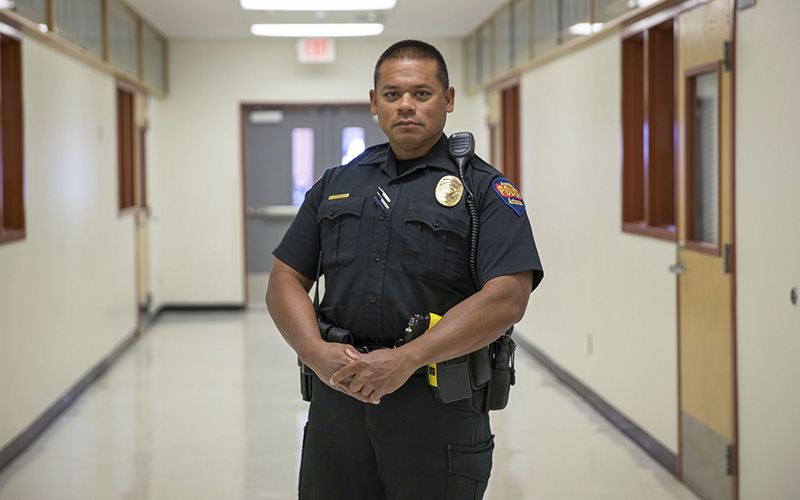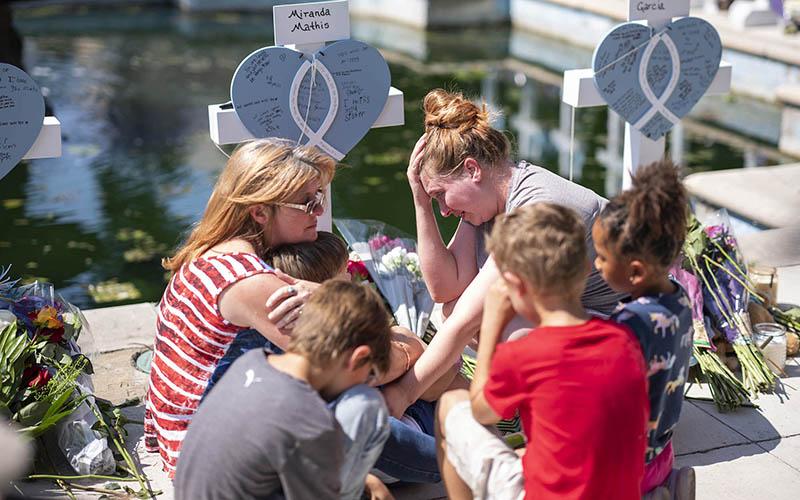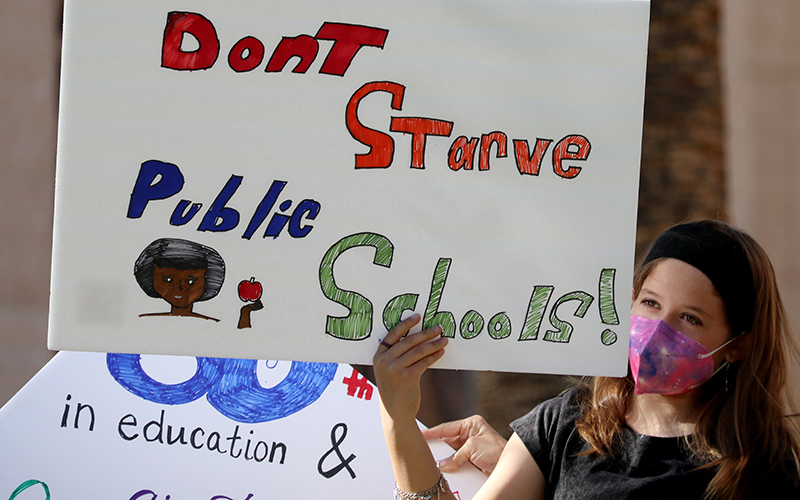
School resource Officer Edward Toves Westview High School in a 2018 file photo. Some have raised concerns about police in schools, but others see them as another way to protect students after another mass shooting. (File photo by Faith Miller/Cronkite News)

Friends of Miranda Mathis, 11, grieve in front of a cross bearing her name. She was one of 19 children killed along with two teachers in a Robb Elementary School in Uvalde, Texas, on May 24 after a gunman entered the school. (Photo by Matthew Busch/CNN)
WASHINGTON – With little hope that state lawmakers will pass gun-control measures in the wake of the latest school shooting, Arizona educators find themselves balancing the competing goals of hardening schools while making them welcoming places.
“You can build a fortress, but a fortress is not very welcoming to parents, students or the community,” said Mark Joraanstad, the executive director of Arizona School Administrators, who said the two “really almost work against each other.”
Experts said the environment inside a school has been shown to reduce violence as much as hardening it on the outside.
“Schools where students feel safe are actually safer,” said Chris Kotterman, director of governmental relations for the Arizona School Boards Association.
But after the May 24 attack on Robb Elementary School in Uvalde, Texas, where a gunman killed 19 students and two teachers before he was killed by police, Arizona schools are revisiting those approaches, along with talk of more school counselors and better relationships with local police agencies.
Uvalde was the 27th school shooting this year, according to Education Week, and the deadliest since the Sandy Hook Elementary School attack in 2012 that killed 20 students and six adults.
“It’s an interesting feeling,” Kotterman said. “It’s equal parts sad and frustrating because, obviously, we’ve been here before.”
One of the most-obvious defenses is to keep gunmen out in the first place. Advocates point to school fencing and locked doors, having one entrance that is monitored at all times, and having safe spots in classrooms where students know they can go.
Saddle Mountain Unified School District has secured “each school office and district office with electronic lock systems and glass shields in each lobby,” Superintendent Paul Tighe said in an email. Phoenix Elementary School District CEO and Superintendent Larry Weeks said in a statement after Uvalde that his district added ballistic glass in front offices and installed secure entry doors where visitors must be granted access.
Another option is improved alarm and alert systems that let staff immediately warn of a threat and remotely lock doors. Dick Foreman, the president and CEO of the Arizona Business and Education Coalition, noted that homeowners have long had the ability to lock house doors remotely and wonders why that technology is not “in every one of our schools?”
Some counties are moving that direction: Schools in Navajo, Mohave, Greenlee and Pinal counties should have Mutualink, which lets school staff hit a panic button to alert police to a school emergency, in place for fall classes. Mutualink Chief Strategy Officer Chrissie Coon said the company expects to have its system in place in Maricopa, Gila, Graham and Yavapai counties by spring.
Besides alerting police, the app gives officers access to cameras, school layouts and real-time communication with staff during an emergency.
Tighe said Saddle Mountain uses similar technology, CrisisGo, that lets any staff member initiate a lockdown or a lockout and immediately notify staff and local authorities. Maps of campus and emergency operations checklists are in the app as well.
Foreman said it’s important for schools to work with police before an emergency, so they have a safety plan when an emergency occurs and to make sure officers are familiar with the campus when they do respond.
In a statement after the Uvalde shooting, Peoria Unified School District Superintendent Jason W. Reynolds said his district’s relationship with Glendale and Peoria police and fire departments has made it a leader in emergency preparation and response. School resource officers are also on all seven of Peoria Unified’s high school campuses.

Enlarged photos are turned into memorials to the 19 children and two teachers killed by a gunman who opened fire May 24 in a Robb Elementary School classroom in Uvalde, Texas. (Photo by Matthew Busch/CNN)
Weeks’ statement emphasized Phoenix Elementary School District’s partnership with law enforcement authorities to conduct campus safety audits.
Critics say such security measures can only go so far, noting issues raised about the response in Uvalde, where it reportedly took more than an hour for officers to enter the classroom and confront the shooter.
Carl Hermanns, an Arizona State University clinical associate professor who has worked with schools on “restorative justice,” noted that schools have been installing high-tech security, securing campus entrances and metal detectors for decades, but shootings continue.
He said such measures, along with proposals to arm teachers and staff or to increase police presence at schools, look to stop shootings that are already in motion instead of eliminating conditions that may start them in the first place.
“They’ve been doing that for years, it’s a billion-dollar business,” Hermanns said. “(Hardening schools) have helped to some extent, but overall, they have not solved the issue. What will help is helping to figure out … how not to let kids get to that point.”
That’s where Hermanns and others say restorative justice can help, by creating accepting school environments where students feel they belong, and addressing harassment and bullying issues. Unlike the “zero tolerance” policies in many schools, it calls on students, staff and teachers to sit down and work to understand why issues may have caused harm and how to fix them.
“For us to really have an impact on school safety, we have to create school cultures and climates that support children and reduce the kind of despair, alienation, disconnection that leads typically, but not always … to school shootings,” Hermanns said.
The West Coast Transformative Justice Center has been teaching restorative practices in Arizona schools since 2017, said Arturo Montoya, restorative justice regional director for the West Coast Mennonite Central Committee. He said the center is currently working with South Pointe High School, the Arizona Center for Youth Resources and Tolleson Elementary, Fowler Elementary and Maricopa Unified school districts.
“It really helps defuse a lot of the tensions … because they feel safe,” Montoya said. “They feel like they’re in a safe environment at school because there is an opportunity (for) somebody to hear them and listen to what their needs are.”
Experts acknowledge there is no data linking these practices to lowered school shootings.
“Doing what I just described in terms of school culture and climate isn’t going to stop every shooting,” Hermanns said. “There will be kids that are so damaged that they’ll get through anyway.”
But restorative justice practices do decrease suspensions and expulsions: Montoya said discipline referrals at Desert Oasis Elementary School fell 135.7% in the year after restorative justice was implemented there in 2018.
“The kids stay in school and they want to be in school and they feel safe at the school,” he said. “A lot of the violence we see is because kids don’t feel safe.”
But Kotterman noted that it “takes time and actual work to develop a culture like that.” That can be a challenge in Arizona, where per pupil spending is among the lowest in the nation and the 716-to-1 ratio of school counselors to students in 2020-21 was almost three times the recommended number of 250-to-1, according to the American School Counselor Association.
Funding “forces you into a literal decision about whether or not I want to spend money on mental health support and other emotional support for my students or paying the people who I already have more money,” Kotterman said. “Students frankly deserve both.”
With most Arizona schools out for the summer, there is time for policymakers, police, mental health professionals and school staff to work on solutions. But Joraanstad said they have their work cut out for them.
“Will you ever eliminate this? No.” Joraanstad said. “But you can reduce the threat and make it more difficult for people who want to perpetuate evil … to be successful.”


